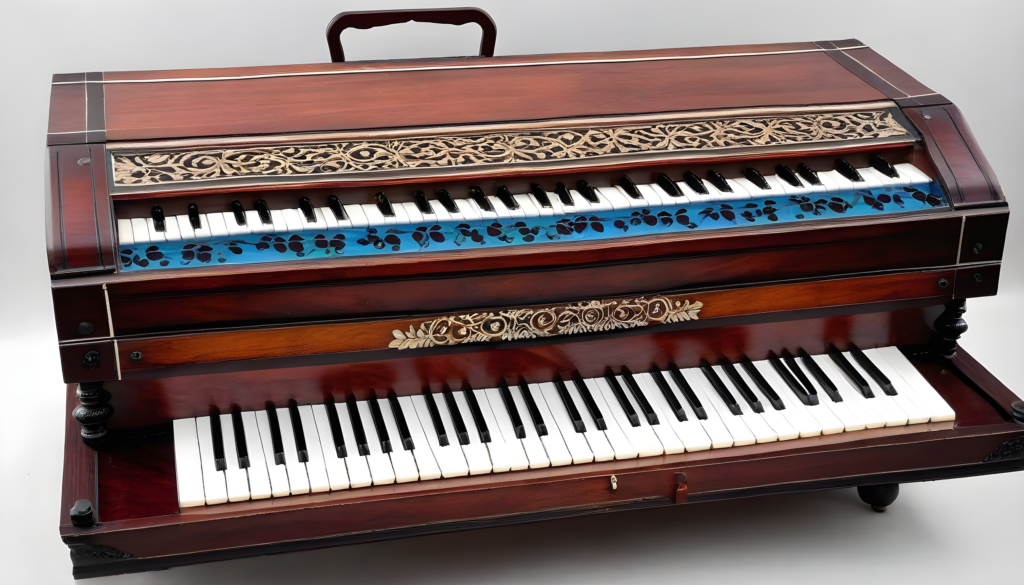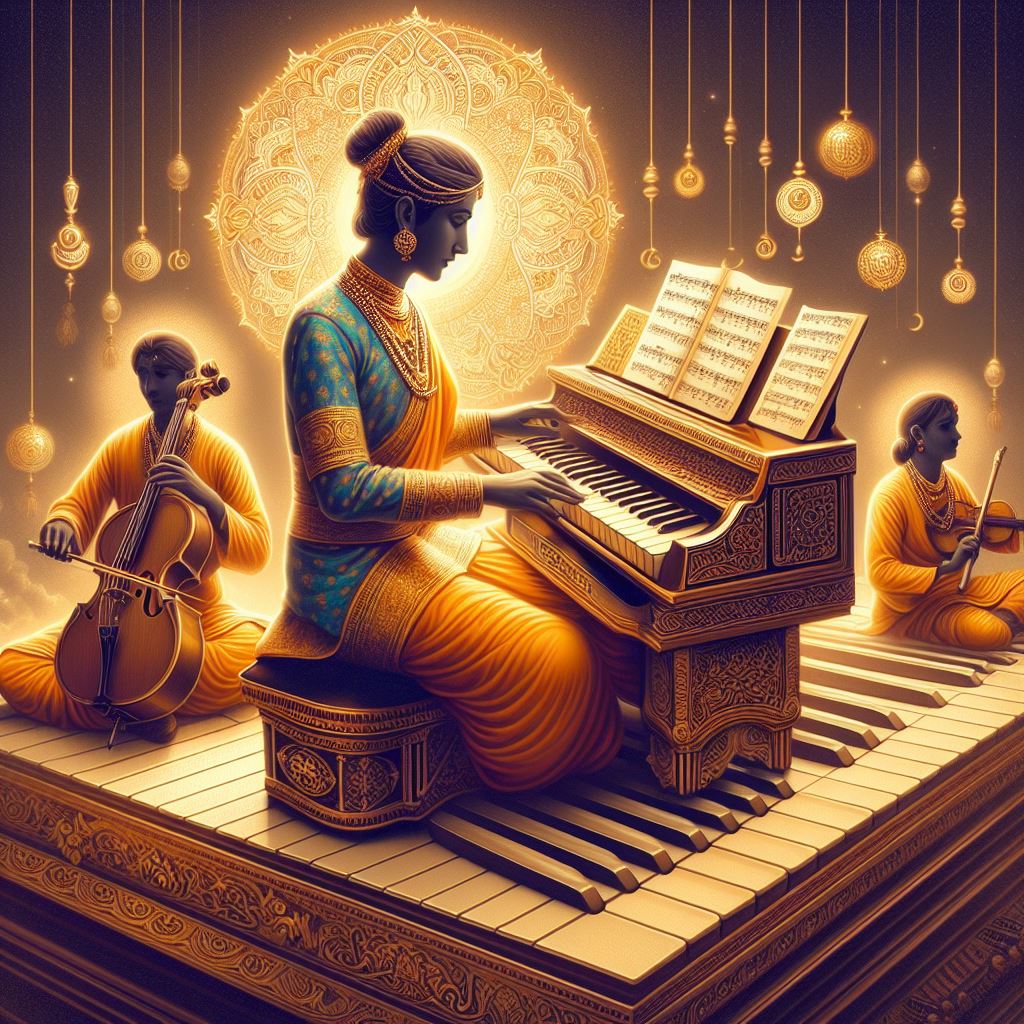Introduction
In the area of holy tune, the harmonium stands as a key player, weaving a symphony that transcends the earthly realm and resonates with the divine. One of the most revered compositions that discover a perfect best friend in the harmonium is Shri Ram Dhun. This sacred chant devoted to Lord Rama turns into a religious adventure while its melodies are skillfully performed on the harmonium. In this exploration, we dive into the difficult art of gambling Shri Ram Dhun on the harmonium, unveiling the techniques and nuances that rework mere strings into a soul-stirring symphony.
The Harmonium: An Instrument of Devotion
- Overview of the Harmonium:
The harmonium, a small and portable reed organ, has become synonymous with devotional songs in India. Its production involves a set of reeds and bellows, operated via foot pumps, permitting the musician to produce sustained notes. The harmonium’s capability to create a non-stop circulation of sound makes it an ideal associate for devotional chants, especially for Shri Ram Dhun.
- Symbolism inside the Harmonium:
Beyond its mechanical structure, the harmonium takes on symbolic importance within the realm of spirituality. The sustained notes symbolize the continuity of devotion, at the same time as the pumping movement of the bellows reflects the rhythmic heartbeat of the worshipper. Playing the harmonium turns into a meditative act, a union of musician and device in the pursuit of spiritual connection.
Shri Ram Dhun: Unraveling the Melodic Tapestry
- Understanding Shri Ram Dhun:
Shri Ram Dhun is a devotional composition that involves the rhythmic chanting of the name “Ram,” invoking the divine presence of Lord Rama. The simplicity of its lyrics belies the profound religious intensity it includes. As a musician embarks on the journey of playing Shri Ram Dhun, an understanding of its lyrical and spiritual nuances is crucial.
- Melodic Structure:
Shri Ram Dhun normally follows a repetitive sample, wherein the call “Ram” is chanted in numerous melodic sequences. The composition allows for inventive interpretation, and the harmonium participant has the power to infuse their personal touch into the rendition. Mastery of the melodic shape is essential for shooting the essence of Shri Ram Dhun.
Harmonium Techniques in Shri Ram Dhun
- Bellows Control:
The harmonium’s bellows play a pivotal role in growing the sustained notes that characterize Shri Ram Dhun. Achieving surest bellows control is an art in itself. The foot pumps need to be operated with precision, ensuring a regular float of air to provide an unbroken, unbroken melody. Mastering this manipulation lets the musician dictate the tempo and emotional intensity of the chant.
- Expressive Use of Stops:
The harmonium is ready with stops that control the airflow to extraordinary reeds, influencing the device’s timbre. In the context of Shri Ram Dhun, a skilful musician employs stops expressively. Opening sure stops can upload brightness to the melody, whilst final others also create a mellower, contemplative mood. The selective use of stops is a nuanced method that complements the emotional effect of the rendition.
- Articulation and Phrasing:
Shri Ram Dhun, no matter its repetitive nature, demands artful articulation and phraseology. The harmonium participant ought to recognize and express each repetition with readability and purpose. This entails cautious interest in the assault and release of every notice, creating a dynamic and expressive rendition that elevates the religious experience for each musician and listener.
- Dynamic Playing:
The harmonium, even though restricted in its dynamic variety as compared to some other gadgets, allows for subtle versions in volume. A professional participant is familiar with the way to infuse dynamics into the overall performance. This can contain steadily increasing or decreasing the volume, creating peaks and valleys within the musical landscape, and including a measurement of the emotional intensity of the chanting.
- Syncopation and Rhythmic Flourishes:
While Shri Ram Dhun often follows a truthful rhythmic pattern, a seasoned harmonium participant can introduce syncopations and rhythmic flourishes. These versions upload a touch of spontaneity to the rendition, preserving the musical fresh and tasty. Careful attention while introducing such elaborations is a sophisticated talent that complements the general expressiveness of the overall performance.
Maestros of Harmonium in Shri Ram Dhun
- PanditBhimsen Joshi:
The mythical vocalist PanditBhimsen Joshi, regarded for his mastery of Hindustani classical song, verified profound information about the harmonium’s capacity in devotional music. His renditions of Shri Ram Dhun exhibit now not only the most effective vocal brilliance but also a symbiotic relationship with the harmonium, where each complements and enhances the alternative.
- PanditRaghunath Seth:
Renowned flautist PanditRaghunath Seth is equally adept at the harmonium. His interpretations of Shri Ram Dhun on the harmonium showcase a continuing integration of classical intricacies with holy zeal. His use of the harmonium as a melodic and expressive instrument has motivated generations of musicians.
- Ustad Sultan Khan:
While on the whole recognized for his mastery of the sarangi, Ustad Sultan Khan additionally left an indelible mark on the harmonium. His collaborations with vocalists and his solo performances highlight the harmonium’s potential for difficult melodic expression, specifically in the context of devotional tracks.
Practice Techniques for Aspiring Harmonium Players
- Repetition and Memorization:
Given the repetitive nature of Shri Ram Dhun, aspiring harmonium gamers greatly benefit from disciplined repetition and memorization. This no longer most effectively builds muscle memory; however, it additionally lets the musician be conscious of expressive nuances rather than analyzing notes.
- Listening and Absorption:
Actively being attentive to various renditions of Shri Ram Dhun, both vocal and instrumental, helps soak up one-of-a-kind interpretations and patterns. This publicity complements musical vocabulary, fosters a deeper knowledge of phrasing, and evokes innovative expression during one’s very own overall performance.
- Breath Control:
Since the harmonium’s sound is produced with the aid of the flow of air through reeds, developing green breath manipulation is important. Harmonium gamers often underestimate the physicality of gambling on the device. Practising breath management exercises far from the instrument can drastically enhance stamina and control in the course of overall performance.
- Slow Practice with Focus on Expression:
Slowing down the pace for the duration of practice lets the musician focus on expressive gambling. This planned method enables refining articulation, phrasing, and dynamic manipulation. As proficiency is received at a slower pace, regularly increasing the pace guarantees a smooth and controlled transition to faster renditions.
- Record and Evaluate:
Recording exercise classes presents treasured remarks. Listening to recordings permits the musician to identify areas for improvement, study nuances in their playing, and refine their technique. Self-assessment becomes an effective device for non-stop boom.
The Spiritual Journey Through Melody

Playing Shri Ram Dhun on the harmonium is not simply a technical exercise; it’s a non-secular adventure where the musician becomes a conduit for divine expression. The harmonium, with its humble outside, transforms into a vessel that includes the worshipper and the listener to realms beyond the international fabric.
- Meditative Connection:
As the harmonium participants immerse themselves inside the repetitive chanting of Shri Ram Dhun, a meditative connection unfolds. The rhythmic pulsations grow to be a heartbeat, guiding the musician and the audience into a state of targeted tranquillity. The harmonium, at this moment, turns into an extension of the worshipper’s spiritual expression.
- Emotional Resonance:
The harmonium’s potential to convey the emotional nuances of Shri Ram Dhun is a testament to its significance in devotional tune. Through skilful manipulation of stops, dynamic gambling, and rhythmic versions, the musician communicates the emotional depth of devotion. Each notice turns into a brushstroke on the canvas of the worshipper’s coronary heart.
- Communal Worship:
The harmonium’s role extends past the individual musician to communal worship settings. In devotional gatherings, the harmonium turns into a unifying pressure, guiding the collective voices closer to a harmonious combination of melody and devotion. The shared experience of playing and taking note of Shri Ram Dhun creates a non-secular tapestry that binds worshippers collectively.
- Transcendence Through Sound:
Shri Ram Dhun, when played at the harmonium with devotion and skill, has the strength to go beyond the restrictions of language and ideas. The harmonium player will become a mediator, providing a sonic pathway for the worshipper to hook up with the divine. In this transcendence, the boundaries between the fabric and the non-secular blur and the harmonium’s symphony turn into a vehicle for soulful elevation.
Conclusion:
In the hands of a skilled harmonium player, Shri Ram Dhun’s melodies rework right into a cascade of notes that resonate inside the heart and soul. The harmonium’s symphony becomes a religious adventure, traversing nation-states of devotion and expression. From the problematic strategies of bellows manipulation to the expressive use of stops and the incorporation of rhythmic prospers every detail contributes to a harmonious tapestry of sound and spirituality. Aspiring harmonium gamers embarking on the journey of gambling Shri Ram Dhun find themselves no longer best honing their musical competencies but additionally deepening their spiritual connection.
The harmonium, with its unassuming presence, will become a conduit for the divine, allowing the worshipper to take part in a timeless culture of devotional expression. In the echo of every played observation, the harmonium weaves a melody that transcends the confines of the tool itself. It turns into a resonant string within the cosmic symphony, echoing the eternal vibrations of devotion and connecting the mortal with the divine. As the harmonium’s strings vibrate, they devise ripples that expand beyond the physical device, reverberating through the soul and echoing inside the eternity of spiritual expression.
About Us and Feedback
Wе hopе that you will find this information usеful, and if you arе satisfiеd with thе information you havе rеcеivеd from us, plеasе providе us with your fееdback and lеt us know what kind of information about Indian musical instrumеnts wе can providе to you in thе futurе for thе еntirе globе.
